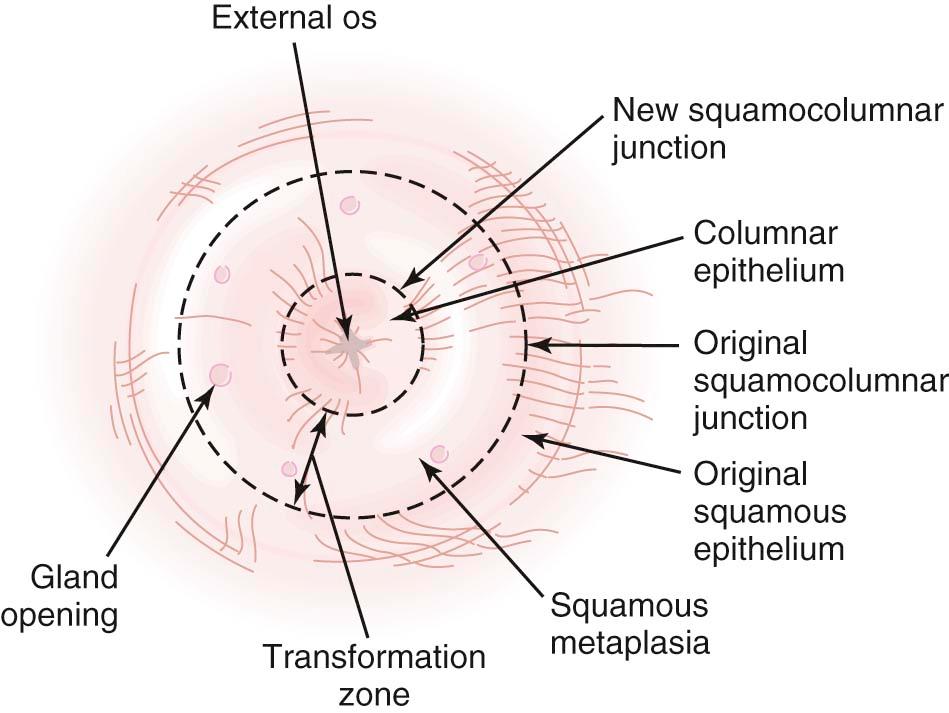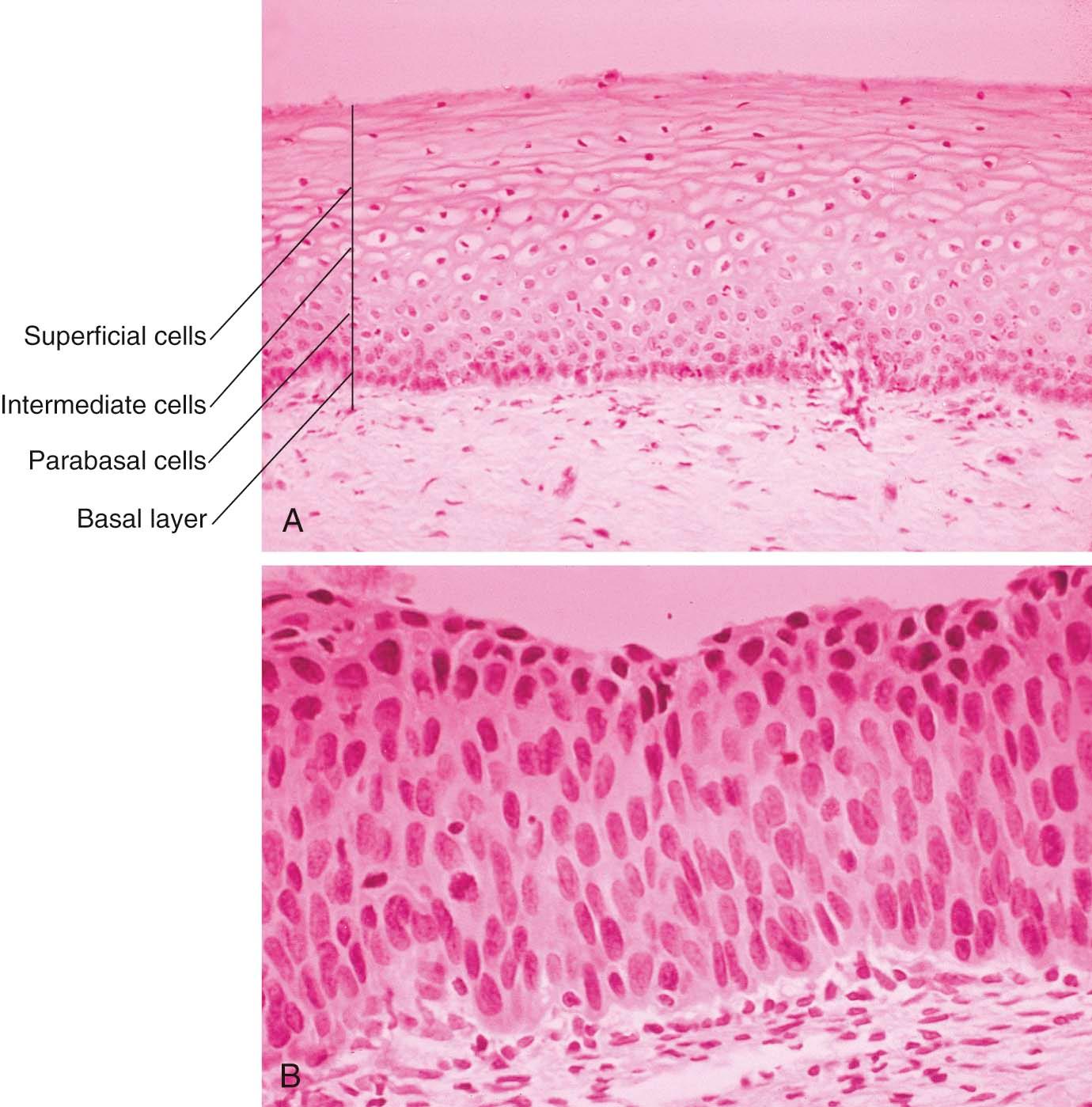Physical Address
304 North Cardinal St.
Dorchester Center, MA 02124
Cervical cancer is the major cause of death from cancer in women worldwide, but most new cases and deaths occur in developing countries where screening for cervical cancer is poorly developed.
Cervical cancer is caused by persistent infection with a high-risk human papillomavirus (HPV), and vaccines have been developed against some of these viruses. Vaccination of girls (and boys) before they are sexually active should significantly decrease the incidence of cervical cancer in the future.
Persistent infection with a high-risk HPV virus initially produces an intraepithelial lesion called high-grade squamous intraepithelial lesion. This entity can be detected by screening with a Papanicolaou smear, liquid-based cytology, or a primary HPV test, and successfully treated, thereby preventing the development of invasive cervical cancer.
Invasive cancer of the cervix usually occurs between 40 and 60 years of age and most commonly presents early because of postcoital bleeding if the woman is sexually active. If she is not sexually active, the disease may remain asymptomatic until it is quite advanced.
All patients with cervical cancer may be treated with chemoradiation, usually involving a combination of external beam therapy followed by brachytherapy. Radical hysterectomy and pelvic lymphadectomy is a less morbid and equally effective approach for patients with early stage disease.
Cervical cancer is the third most common cancer in women worldwide, after breast and colorectal cancer, but it is the major cause of death from cancer in women, killing around 275,000 women a year. About 80% of new cases occur in developing countries, where cervical screening programs are limited or nonexistent. In developed countries, regular screening has markedly decreased the incidence of the disease, and most cases now occur in women who have not had regular Papanicolaou smears. In the United States, cervical cancer now ranks only 13th among cancers in women, with 12,340 new cases expected in 2013, and 4030 deaths.
Studies have identified persistent infection with a high-risk human papillomavirus (HPV) as the cause of virtually all cervical cancers. Randomized clinical trials of prophylactic HPV vaccines have demonstrated dramatic efficiency in preventing HPV 16 and 18 infections, as well as precancerous cervical lesions. Although it will take several decades to demonstrate a decreased incidence of invasive cervical cancer, with widespread use, HPV vaccination should markedly decrease the incidence of cervical cancer in future generations.
There are 15 high-risk HPV types and types 16 and 18 are responsible for 70% of cervical cancers. Types 6 and 11 have been associated with cervical condylomas and low-grade cervical intraepithelial neoplasia (CIN).
The adolescent cervix is believed to be more susceptible to carcinogenic stimuli because of the active process of squamous metaplasia, which occurs within the transformation zone during periods of endocrine change. This squamous metaplasia is normally a physiologic process, but under the influence of the HPV, cellular alterations occur that result in an atypical transformation zone. These atypical changes initiate CIN, which is the preinvasive phase of cervical cancer.
Cervical cancer and its precursors have been associated with several epidemiologic variables ( Box 38-1 ). These risk factors basically increase the likelihood of exposure to a high-risk HPV type.
Young age at first coitus (<17 yr)
Multiple sexual partners
Sexual partner with multiple sexual partners
Young age at first pregnancy
High parity
Lower socioeconomic status
Smoking
The disease is relatively rare before 25 years of age, and the mean age is about 47 years.
Two prophylactic vaccines are presently available. The quadrivalent vaccine Gardasil, which is manufactured by Merck and Co. and protects against HPV types 6, 11, 16, and 18, was approved by the U.S. Food and Drug Administration (FDA) in June 2006 for females aged 9 through 26 years. The bivalent vaccine Cervarix, which is manufactured by Glaxo Smith Kline and protects against HPV types 16 and 18, was approved by the FDA in October 2009, for use in females aged 10 through 25 years.
HPV vaccination is most effective if performed before the onset of sexual activity. Vaccination is still recommended after commencement of sexual activity, and even after prior abnormal cytology or CIN, but it is likely to be less effective after HPV exposure. In 2007, Australia was the first country in the world to introduce HPV vaccination into the National Immunization Program for all schoolgirls aged 12 years.
The American College of Obstetricians and Gynecologists (ACOG) has recommended that all women should undergo an annual physical examination, including a Papanicolaou (Pap) smear, within 3 years of sexual intercourse, or by age 21. The false-negative rate for conventional Pap smears for high-grade intraepithelial lesions is generally reported to be about 20%, but it is higher for glandular lesions and for invasive cancers.
New technologies have been developed to decrease the false negative rate. Thin Prep (Cytyc Corporation) and Surepath (TriPath Imaging) are automated liquid-based slide-preparation systems. With liquid-based cytology (LBC), the spatula or brush taking the smear is placed into a fixative solution, instead of smearing the cells directly onto a glass slide. Blood, mucus, and inflammatory cells are eliminated and a monolayer smear is then automatically prepared by a machine. Focal Point (Surepath) and ThinPrep Imager (Cytyc) are computerized image processors that select the most abnormal cells on a slide. They increase the sensitivity of slide reading, while decreasing the time needed by the cytotechnician to read each slide, thereby improving the cost effectiveness of screening.
The American Society for Colposcopy and Cervical Pathology (ASCCP) has recommended that screening with Liquid Based Cytology (LBC) should occur every 3 years from 21 to 30 years. Thereafter, they recommend continued screening every 3 to 5 years with LBC for HPV testing. Both the endocervical canal and the exocervix (or ectocervix) should be sampled when taking the Papanicolaou smear.
HPV deoxyribonucleic acid (DNA) testing is much more sensitive than cervical cytology, but less specific. It is presently being investigated as a primary screening test for women after the age of 25 to 30 in many developed countries. The negative predictive value of the HPV test is very high, so screening intervals could safely be extended to at least 5 years. If the HPV test is positive, reflex cervical cytology is performed to determine the need for referral for colposcopy.
Women should have regular cervical screening even if they have received the HPV vaccine, because the vaccine does not protect against all high-risk HPV viral types.
During early embryonic development, the cervix and upper vagina are covered with columnar epithelium. During intrauterine development, the columnar epithelium of the vagina is progressively replaced by squamous epithelium. At birth, the vagina is usually covered with squamous epithelium, and the columnar epithelium is limited to the endocervix and the central portion of the exocervix (or ectocervix). In about 4% of normal female infants, the columnar epithelium extends onto the vaginal fornices. Macroscopically, the columnar epithelium has a red appearance because it is only a single cell layer thick, allowing blood vessels in the underlying stroma to show through it.
The embryologic squamous and columnar epithelia are designated the original or native squamous and columnar epithelia, respectively. The junction between them on the exocervix (or ectocervix) is called the original squamocolumnar junction.
Throughout life, but particularly during adolescence and a woman's first pregnancy, metaplastic squamous epithelium covers the columnar epithelium so that a new squamocolumnar junction is formed more proximally. This junction moves progressively closer to the external os and then up the endocervical canal. The transformation zone is the area of metaplastic squamous epithelium located between the original squamocolumnar junction and the new squamocolumnar junction ( Figure 38-1 ).

In 1988, a consensus meeting was convened by the Division of Cancer Control of the National Cancer Institute to review existing terminology and to recommend effective methods of cytologic reporting. As a result of this meeting, the Bethesda system was devised and requires (1) a statement regarding the adequacy of the specimen for diagnosis, (2) a diagnostic categorization (normal or other), and (3) a descriptive diagnosis. A revised Bethesda system was developed in 2001 and is shown in Box 38-2 .
Satisfactory for evaluation (note presence/absence of endocervical/transformation zone component)
Unsatisfactory for evaluation (specify reason)
Specimen rejected/not processed (specify reason)
Specimen processed and examined, but unsatisfactory for evaluation of epithelial abnormality because of (specify reason)
Negative for intraepithelial lesion or malignancy
Epithelial cell abnormality
Other
Organisms (e.g., Trichomonas vaginalis )
Reactive cellular changes associated with inflammation (includes typical repair), radiation, intrauterine contraceptive device
Atrophy
Atypical squamous cells of undetermined significance (ASCUS) cannot exclude high-grade squamous intraepithelial lesions (ASC-H)
Low-grade squamous intraepithelial lesion (LSIL) encompassing: human papillomavirus/mild dysplasia/cervical intraepithelial neoplasia (CIN I)
HSIL encompassing: moderate and severe dysplasia, carcinoma in situ; CIN 2 and CIN 3
Squamous cell carcinoma
Atypical glandular cells (AGC) (specify endocervical, endometrial, or not otherwise specified)
Atypical glandular cells, favor neoplastic (specify endocervical or not otherwise specified)
Endocervical adenocarcinoma in situ (AIS)
Adenocarcinoma
For example, endometrial cells in a woman ≥40 years of age
CIN represents a spectrum of disease, ranging from LSIL, low-grade squamous intraepithelial lesion (formerly called CIN I or mild dysplasia) to HSIL, high-grade squamous intraepithelial lesion (formerly called CIN II and III, or moderate and severe dysplasia). At least 35% of patients with HSIL will develop invasive cancer within 10 years, whereas LSIL often spontaneously regresses. With CIN, there is abnormal epithelial proliferation and maturation above the basement membrane. Involvement of the inner one-third of the epithelium represents LSIL, while involvement of the outer two-thirds represents HSIL ( Figure 38-2 ). The disease is asymptomatic.

The colposcope is a stereoscopic binocular microscope of low magnification, usually 10× to 40×. Illumination is centered, and the focal length is between 12 and 15 cm.
To perform a colposcopic examination, an appropriately sized speculum is inserted to expose the cervix, which is cleansed with a cotton pledget soaked in 3% acetic acid to remove adherent mucus and cellular debris. A green filter can be employed to accentuate the vascular changes that frequently accompany pathologic alterations of the cervix.
At colposcopy, the original or native squamous epithelium appears gray and homogeneous. The columnar epithelium appears red and grapelike. The transformation zone can be identified by the presence of gland openings that are not covered by the squamous metaplasia and by the paler color of the metaplastic epithelium compared with the original squamous epithelium. Nabothian follicles may also be seen in the transformation zone. Normal blood vessels branch like a tree.
Become a Clinical Tree membership for Full access and enjoy Unlimited articles
If you are a member. Log in here